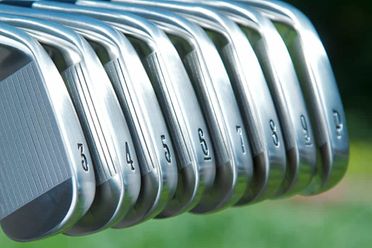
To master the shallower golf swing, it is important to understand how to create the correct forces. Some things can hinder your ability to master this technique. These include gripping the club too tightly and trying to rotate your upper body too quickly. Hip rotation is vital for a perfect shallow swing. It directs your force into the shot.
Deeper angle
The angle that the golf clubhead approaches and strikes the ball is known as the angle of attack. The direction of your swing will be determined by how ascending or descendant the angle is. A positive angle of attack characterizes an ascending blow. Conversely, a negative angle is used to describe a descending blow.

Increased force
The best way to increase power is to smile while you swing the golf club. This technique allows the clubface to strike the ball directly and can improve shots for all players. Golfers should be cautious with this technique. If you don't know how to do it correctly, it can cause problems.
Fat shots
Fat shots from a shallow golf swing are caused by the inability to rotate correctly in the upper body and spine. This causes a lower swing arc and lower ball velocity. Bobbing can also be caused by this type of golf swing. This can be reduced by changing the angle of the spine and the upper body rotation in order to increase the swing's arc.
Big misses
A shallower golf swing will result in a flatter path and a lower angle of attack. This is easiest achieved by tilting your shoulders and hips backward. Swinging too strongly can cause the club not to lower before the shoulders have a chance to untwist. At impact, the club flips to the left shoulder and the arms try pull it backward.
Controlled improvement
Shallow golf swings give you more control over your club and improve your consistency, especially if you are prone to coming over the top. You can make your ball fly straighter with them.

Natural human reaction
If a golfer doesn't keep his upper body and lower body separate, it can lead to shallow golf swings. He is not using his hips to start the downswing and as a result, the ball will end up too far to the right. This causes the golfer to shank the ball. Golfers can avoid this by recording their swings on the driving range or course.
FAQ
Do I require any special skills to play or practice golf?
No. You only need a pair or walking shoes, a towel, as well as a few clubs.
How much does a round of golf cost?
Prices for each person can be anywhere from $15 to $30 This includes greens fees and cart rental.
What is a "handicap"?
Sometimes it can be difficult to keep up with your fellow golfers. You may also struggle to score high because you are either too slow, or too fast. Hire a caddy who will carry your bag on your behalf to overcome these issues.
You should still take advantage the local golf club's services if you're just starting out. Your handicap is calculated using your gender, age, height, weight and skill level.
Your handicap will then serve as a guideline for calculating your score. Your handicap will indicate which group you fall into. This will enable your to compete more effectively with other players with similar abilities.
How often should I go to the golf course?
It depends on how much time you have available. However, most people recommend practicing two times per week.
Four times a week is the ideal number to be an expert golfer.
What is the best time of year to play golf?
Between May and September is the best time to play golf. The weather is mild, there's no rain and it's generally not too hot.
It can get very cold in winter. Snowfall can make it difficult for fairways to be walked.
Spring and autumn are difficult to see because the grass is too tall.
How is golf scored?
The scorecard is broken down into four distinct categories: Stroke Play (Par 3, Par 4 and Par 5), and Stroke Play (Par 3 & Par 4). Each category can also be broken down into strokes. To achieve par, a player must complete 18 of 72 holes (Par 72).
The lowest score wins.
Statistics
- He shanked the first attempt, but it is estimated his second went more than 200 yards (180 m).[52]Golf courses worldwide. Below are the top 20 countries with the most golf courses as of 2019.[53]CountryNumber of (en.wikipedia.org)
- They do this by means of assessing and rating courses according to the average good score of a "bogey golfer," a player with a handicap of around 20. (en.wikipedia.org)
- Professional golfers typically make between 60% and 70% of greens in regulation. (en.wikipedia.org)
- Buying a set of Titleist or Taylor-Made irons for nearly $1,000 is simply not necessary and likely a waste of money. (golficity.com)
External Links
How To
How can you play better golf when the wind blows?
Golf is an outdoor game that can be played on grassy, open areas. It is one the most loved sports in the world. There are many courses available, including public and private. You can also play indoors such as indoor arenas or shopping malls. The game consists of a series of holes, where players must hit balls into them. Each hole features a fairway and rough, hazards (e.g.. water), and a teebox. Depending on the type of shot, players can use a driver or wedge, long iron, putter or long iron. Players may be required to carry the ball a certain distance before they can hit it. Or, they may just have to drop it in the cup. When playing outdoor golf, various conditions affect how the player hits his/her shots. These include temperature, humidity and visibility.
There are two main types: crosswinds, and headwinds. Headwinds blow left to right and crosswinds from left to right. If the wind blows towards the golfer, he/she is playing against the wind. However, if the wind blows away from the golfer, he/she will hit with the wind. Playing golf in a strong wind is much harder because the ball tends to fly higher and further. This makes it more difficult for players to control the ball's direction and trajectory. To counter these effects, players keep the club's face perpendicular with the ground. They strike the ball in such a way as to get maximum power and full contact with it. However, even though the ball flies lower in stronger wind, it travels farther due to increased air resistance.
You need to practice a lot when playing golf in the wind. The wind influences the ball's flight path. A great golfer should be aware of what type of wind is blowing in the area. He/She would adjust the swing to compensate so that the ball can be hit cleanly and with minimal energy. Another important factor to consider is the location of the wind. The wind is not always consistent in its direction. For example, the breeze that blows off the ocean can be very light, but it can often be stronger near the shoreline. Similarly, the wind blows strongest close to the ground. These factors mean that golfers must be aware of the direction and intensity of the wind.
Playing golf in the wind means that your swing must be adjusted constantly. It is important to be aware of the wind and adjust your swing accordingly. Learn to read the wind and adapt your swing accordingly.